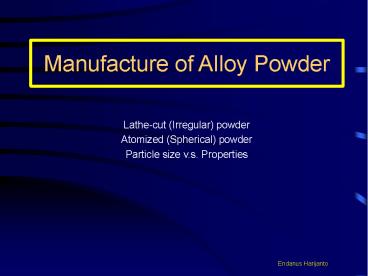Manufacture of Alloy Powder PowerPoint PPT Presentation
Title: Manufacture of Alloy Powder
1
Manufacture of Alloy Powder
- Lathe-cut (Irregular) powder
- Atomized (Spherical) powder
- Particle size v.s. Properties
Endanus Harijanto
2
Lathe-cut (Irregular) Powder
- Metal ingredients ?heated ?poured into a mold ?
ingot (Ag3Sn (g) some b, e, h) - Ingot ? homogenizing anneal
- An annealed ingot of alloy is place in a machine
and is fed into a cutting tool. - 60-120 µm in length, 10-70 µm in width
3
Atomized (Spherical) Powder
- Made by melting the desired elements together
- The liquid metal is atomized into fine spherical
droplets of metal by being sprayed under high
pressure of an inert gas. - ? Spherical powders 2- 43 µm
- Also have heat treatment and are
- usually washed with acid.
4
Homogenizing Anneal
- The ingot is placed in an oven and heated at a
temperature below the solidus (at 400C) for
sufficient time (6-8 hours) to allow diffusion of
the atoms to occur and the phases to reach
equilibrium.
5
Particle Treatments
- Acid-washed amalgam powders
- tend to be more reactive.
- Stress-relief process after particle cutting
- annealing cycle at 100C for several hours
- aging process
6
Lathe-cut v.s. Atomized alloys
- Lathe-cut or admixed powders resist condensation
better than spherical powders. - Spherical alloys require less mercury than
typical lathe-cut alloys because of the smaller
surface area per volume. - Amalgams with a low mercury content generally
have better properties.
7
Particle Size
- A powder containing tiny particles requires a
greater amount of mercury to form an acceptable
amalgam. - A small-to-average particle size ? a more rapid
hardening and a greater early strength - Particle size distribution can affect the
character of the finished surface. - The larger particles may be pulled out during
carving ? a rough surface ? corrosion
8
Amalgam Alloy Composition
- ANSI/ADA Spec. 1 (ISO 1559) requires that
amalgam alloys be predominantly silver (Ag) and
tin (Sn). - containing Zn gt 0.01 ? Zinc Containing
- containing Zn lt 0.01 ? nonzinc
9
Classification
- Low-copper (Conventional) amalgam alloy
- (at least 65 wt Ag, 29 wt Sn, lt 6 wt Cu)
- lathe-cut (irregular) powder or spherical
particles or mixed - Ag-Sn
- High-copper amalgam alloy
- (6-60 wt Cu)
- (1) Admixed (Ag-Sn Ag-Cu)
- A mixture of irregular and spherical particles of
different or same composition - (2) Unicomposition or Single composition
(Ag-Sn-Cu) - All spherical particles
? 90 of the dental amalgams currently placed

